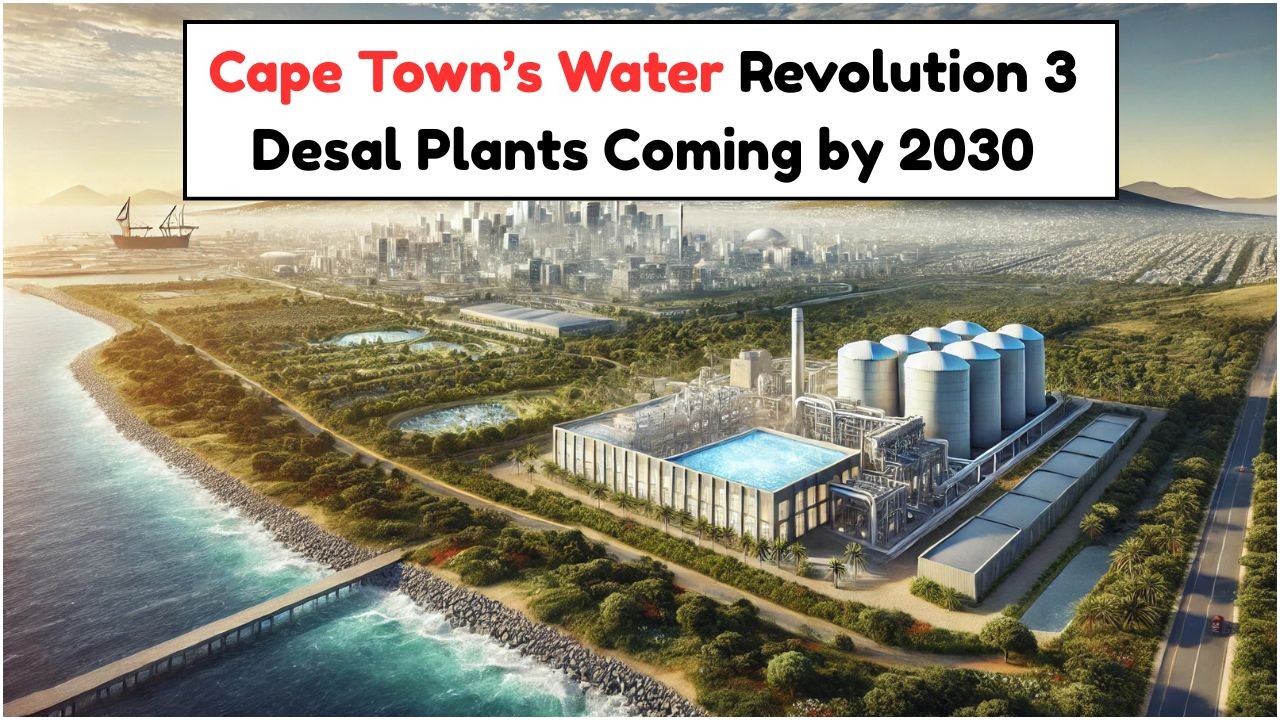Cape Town’s 2030 Water Masterplan: In the face of recurring droughts and growing water scarcity, Cape Town’s 2030 Water Masterplan emerges as a beacon of hope for residents. The ambitious initiative aims to secure a sustainable water future for the city by implementing a multifaceted approach that includes the construction of three massive desalination plants. As the city grapples with the effects of climate change, these efforts are expected to provide much-needed relief from the burden of exorbitant water bills while ensuring a reliable water supply for the region’s population. The Masterplan’s focus on renewable energy sources and innovative water conservation measures promises not only to address immediate challenges but also to pave the way for long-term ecological balance.
Understanding the 2030 Water Masterplan and Its Impact
The Cape Town 2030 Water Masterplan is a comprehensive strategy designed to enhance water security and manage the city’s resources more efficiently. By emphasizing sustainable practices and technological advancements, the plan aims to mitigate the impact of climate change and ensure a continuous supply of clean water. Key components of the Masterplan include the construction of three large-scale desalination plants, which will collectively produce millions of liters of potable water daily. These facilities will tap into the abundant sea resources available along the coast, reducing reliance on traditional freshwater sources.
- Embracing innovative technologies to boost water efficiency.
- Enhancing infrastructure to minimize water loss through leaks.
- Promoting community awareness and participation in water conservation.
- Investing in renewable energy to power water treatment facilities.
- Utilizing data-driven approaches for better resource management.
- Strengthening partnerships with local and international stakeholders.
- Implementing stringent monitoring and evaluation mechanisms.
Three Massive Desalination Plants: The Backbone of the Plan
Central to the success of the Cape Town 2030 Water Masterplan are the three massive desalination plants strategically located along the coast. Desalination, the process of removing salt from seawater to produce fresh water, is a critical component of the city’s strategy to bolster water supply amid fluctuating rainfall patterns. These plants, expected to be operational by 2030, will significantly increase the city’s water production capacity, ensuring a steady flow of potable water to households and businesses alike.
| Plant Name | Location | Capacity (ML/day) | Energy Source | Operational Date | Cost (ZAR) | Job Creation | Environmental Impact |
|---|---|---|---|---|---|---|---|
| Atlantic Plant | Table Bay | 150 | Solar | 2027 | 1.5 billion | 200 | Minimal |
| Indian Ocean Plant | False Bay | 180 | Wind | 2028 | 1.8 billion | 250 | Low |
| Southern Plant | Hout Bay | 170 | Hydro | 2029 | 1.6 billion | 220 | Negligible |
Long-Term Benefits of Cape Town’s Water Strategy
Implementing the 2030 Water Masterplan offers several long-term benefits that extend beyond immediate water supply issues. By securing a sustainable water source through desalination, Cape Town can better manage its natural resources and reduce dependency on erratic rainfall patterns. This strategic shift not only ensures water availability during dry spells but also stabilizes water prices, offering permanent relief to consumers struggling with high bills. Additionally, the emphasis on renewable energy in powering desalination plants aligns with South Africa’s commitment to reducing carbon emissions and promoting environmental sustainability.
- Consistent and reliable water supply throughout the year.
- Economic growth driven by job creation in the green technology sector.
- Reduced pressure on existing freshwater sources and ecosystems.
- Enhanced resilience to climate change and drought conditions.
- Promotion of sustainable urban development practices.
Challenges and Solutions in Implementing the Plan
While the Cape Town 2030 Water Masterplan holds promise, its implementation is not without challenges. Key obstacles include the high initial costs of desalination technology, potential environmental impacts, and the need for skilled labor to operate and maintain the plants. To address these issues, the city is exploring innovative financing models, such as public-private partnerships, to fund the projects. Additionally, rigorous environmental assessments are conducted to ensure minimal disruption to marine life and ecosystems.
| Challenge | Solution | Outcome | Stakeholders Involved |
|---|---|---|---|
| High Costs | Public-Private Partnerships | Reduced financial burden on taxpayers | Government, Private Sector |
| Environmental Concerns | Rigorous Assessments | Minimal ecological impact | Environmental Agencies |
| Skilled Labor Shortage | Training Programs | Increased local employment | Educational Institutions |
| Community Engagement | Awareness Campaigns | Higher public support | NGOs, Local Communities |
| Technological Implementation | Research & Development | Advanced solutions | Research Institutes |
Community Involvement in Cape Town’s Water Initiatives
Community involvement is a cornerstone of the Cape Town 2030 Water Masterplan. Educating residents about water conservation techniques and encouraging their participation in sustainable practices are crucial for the plan’s success. By fostering a sense of responsibility and ownership among citizens, the city aims to create a culture of conservation that extends beyond individual households to businesses and industries.
- Regular workshops and seminars on water-saving techniques.
- Incentives for businesses to implement water-efficient technologies.
- School programs to educate the younger generation on water issues.
- Community-led initiatives for rainwater harvesting and greywater recycling.
- Partnerships with local media to raise awareness on water conservation.
The Role of Technology in Water Management
| Technology | Application | Benefits | Examples |
|---|---|---|---|
| Smart Meters | Real-time water usage monitoring | Reduced wastage, informed decisions | Smart Water Solutions |
| AI and Data Analytics | Predictive maintenance of infrastructure | Enhanced operational efficiency | Water Intelligence Systems |
| Advanced Filtration | Improved water quality | Safe drinking water | Pure Water Technologies |
| Renewable Energy | Powering desalination plants | Lower carbon footprint | Green Energy Desalination |
Future Prospects for Water Management in South Africa
The Cape Town 2030 Water Masterplan sets a precedent for other regions in South Africa facing similar water challenges. By demonstrating the viability of desalination and sustainable water management practices, Cape Town serves as a model for addressing water scarcity across the nation. The insights gained from this initiative could inform broader national policies and strategies aimed at securing water resources for future generations.
- Increased investment in water technology research and development.
- Expansion of desalination to other coastal cities.
- Development of national water resilience frameworks.
- Integration of water management into urban planning.
- Collaboration with international partners to share expertise and resources.
FAQ Section
Frequently Asked Questions about Cape Town’s Water Masterplan
What is the main goal of the Cape Town 2030 Water Masterplan?
The main goal is to ensure a sustainable water supply for the city through innovative solutions like desalination plants and conservation measures.
How will the desalination plants impact water bills in Cape Town?
The plants are expected to stabilize water prices, offering permanent relief from high bills by increasing the city’s water production capacity.
What role does renewable energy play in the Masterplan?
Renewable energy is used to power the desalination plants, reducing the overall carbon footprint and aligning with sustainability goals.
How is the community involved in the Water Masterplan?
The community is engaged through educational programs, conservation campaigns, and incentives for sustainable practices.
What are the expected environmental impacts of the desalination plants?
The plants undergo rigorous environmental assessments to ensure minimal impact on marine life and ecosystems.







